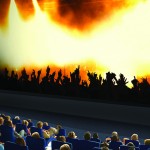Exhibition: alternative content invades Australian screens
 It’s not often that Andre Rieu, Iron Maiden and New York’s Metropolitan Opera descend on regional Australia to perform a strong of live shows, but our cinemas are helping to lure them. Laine Lister writes.
It’s not often that Andre Rieu, Iron Maiden and New York’s Metropolitan Opera descend on regional Australia to perform a strong of live shows, but our cinemas are helping to lure them. Laine Lister writes.
It all started with a purple dinosaur, a big red car and four jolly, middle-aged men sporting a rainbow fashion disaster.
It was Christmas 2008 and the illustrious musical group for kids, The Wiggles, lent its name and box office magnetism to launch a novel form of entertainment –alternative content – in turn jump starting new revenues for cinema operators.

